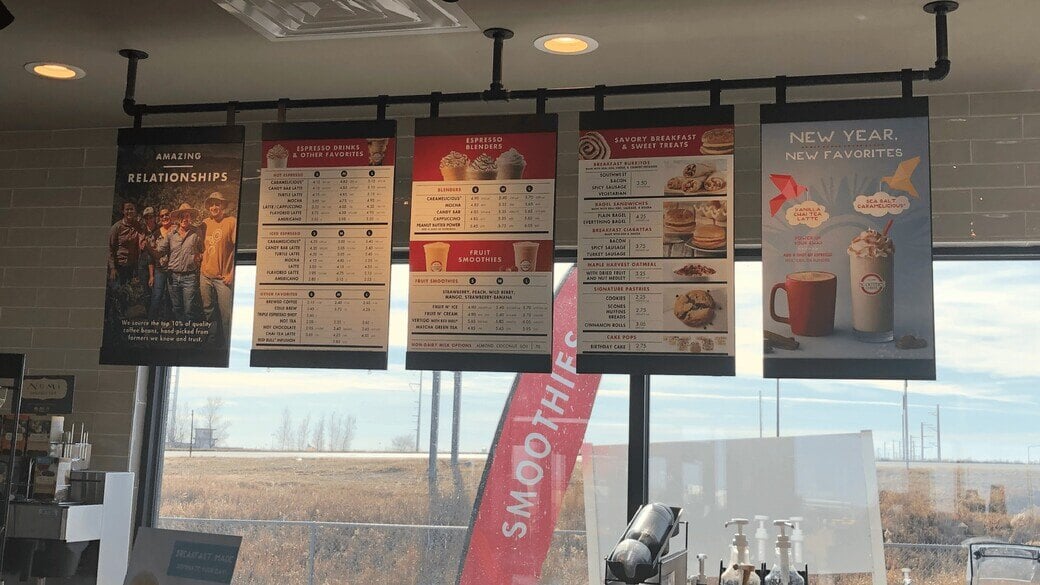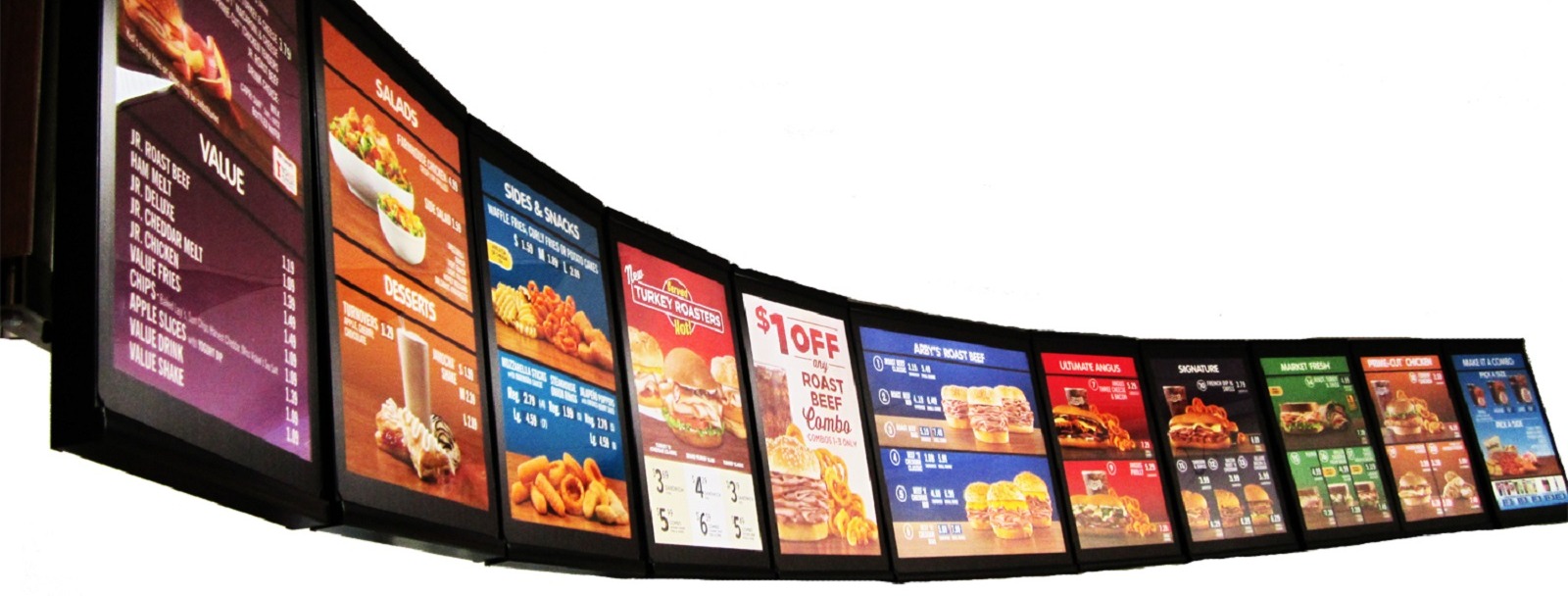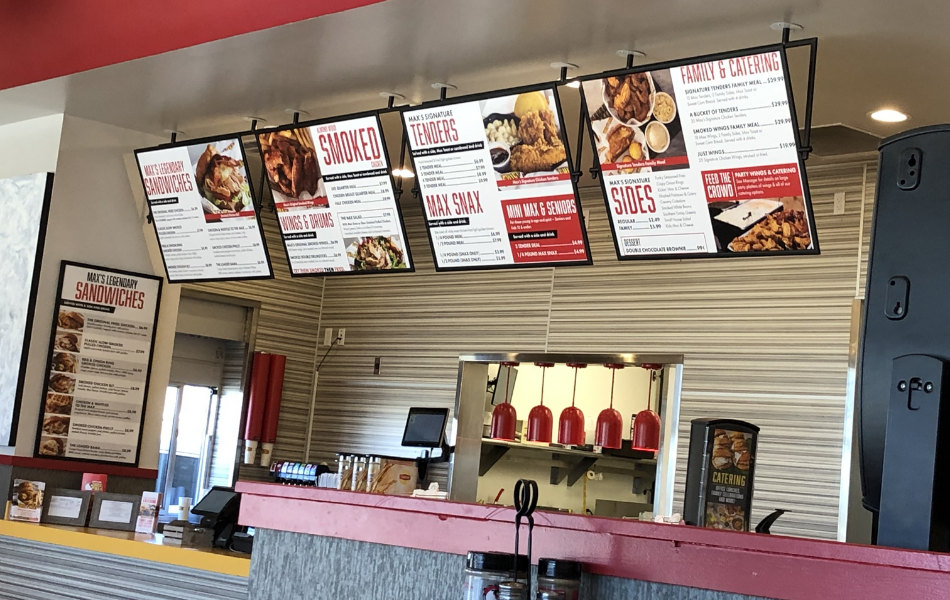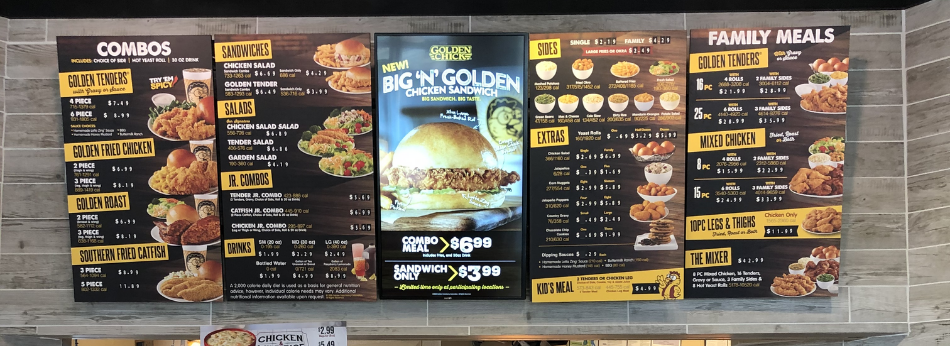How Much Does An Indoor Menu Board Cost?
How Much Does An Indoor Menu Board Cost?
.webp)
How much does an indoor menu board cost in 2025?
There is much to consider when starting a quick-service or counter-service restaurant. But two things probably rise to the top of the list – the menu and the customers. Once you have the menu planned out, with a target audience in mind, you need a way to display it. That's the menu board. You invested a lot so far, and the menu board is probably something you get done towards the end of the project. It is one of the last big-ticket items you must purchase, so how much can you expect to spend to have a beautiful, revenue-generating menu board?
Let's divide this into decision-making categories: type (magnetic, LED, or digital), size (determined by you), and mounting (ceiling-hung or wall-mounted), and we will explain how those things influence the final price tag. Here is a list of questions to ask yourself to decide which is right for you.
Magnetic Menu Boards

Magnetic menu boards are incredibly versatile, and it is easy to stay within budget with this type of board. The menu is a metalized sheet that adheres to a magnetized PVC backboard. The price ranges from $400 to $2,000. Here's why:
- How extensive is your menu? Some restaurants have limited offerings and can fit the whole menu in one or two panels. Others need 6-8 units to display their items and LTOs.
- How big are the panels? Industry-standard sizes are cheaper for the vendor. Custom sizes are also an option but will cost more because of the additional time and effort to cut them to the desired size.
- Do you need a backboard, or will you attach it to another metal surface? Most people opt for metalized magnetic sheets mounted on PVC backboards. We call this our "Benchmark" system. It is a very affordable solution, and it is pretty versatile. Although rare, printed rubber steel is an option if the site has an existing metal surface. It performs similarly to metalized but is a little thicker.
- How thick is the backboard? 13mm PVC is typical and sufficient for most graphic sizes. The PVC has to be sturdy enough to hold the weight of the metalized menu graphics without bending.
- How strong is the magnetized resin film? The material adheres to the backboard, providing the magnetism that the graphic clings to. The glue is important. It must be strong enough to withstand a harsh restaurant environment, with constant exposure to heat and grease. Also, how much magnetic force does it have? There are different grades, which is especially important with larger graphic sizes, where the weight can cause it to peel away from the backboard.
- Can the graphics stand up in the harsh restaurant environment? Over time, the heat and grease can wear down the "cling" between the metalized graphic and the backboard. Some materials have a shorter expected life. Spending more on higher quality material is worth it, so you won't have corners peeling within a few months.
- How are you going to install the menus? They can be ceiling-mounted or wall-hung. Both are viable options, but the decision depends on your space and the distance the board will be from customers.
- Do you want to be able to update prices or menu items without changing the whole board? Instead of a single piece, the menu board would have the main component and a kit of menu strips and price chips. The main menu piece has holes cut where the menu strips and price chips go, making this a very inexpensive way to keep your pricing and menu items current.
LED or Illuminated Menu Boards

Operators use LED menu boards in restaurants where lighting makes them hard to read. The price range is broad, mainly because it depends on how many panels you need and the size of the panels. An LED menu board is a lightbox with the menu printed on transparent polycarbonate. Expect to pay at least $700 for a smaller-sized single 18 "x18" board and around $800 for an 18"x27" board. The boards are usually daisy-chained together, and the most common size has 4-6 panels, meaning the investment will start at around $2,800. Here's what you need to figure out:
- The frames are extruded aluminum, so the sizing is less versatile than a magnetic board. You must check your space to see what fits and how many individual boards you can accommodate.
- How many menu items and LTO's do you want to display? Keep your space limitations in mind when deciding what to offer.
- How are you going to mount the boards? They can be ceiling-hung or wall-mounted, but you need an electrical outlet nearby that the panels can hide. A long electrical cord hanging down the wall is not a great look!
- Do you want to be able to update prices and menu items without reprinting the entire menu? If so, consider having the menu printed without pricing. You can change the prices using lo-tac price stickers.
Digital Menu Boards

If you are looking for the most menu content and creative flexibility, then digital menu boards are your best choice. They are the most expensive up-front and have ongoing operating costs, but most restaurant owners realize that the benefits are worth it. There is no limit to the number of screens. They can be in portrait, landscape, or video wall configurations. Most manufacturers stick to industry standard sizes of 43", 49 ", 55", and 65", but there are smaller and larger options as well. The starting number will be around $1,000 for a single unit of the smaller size, but the price can get into the $4,000-$10,000 range as you add screens, software, warranties, and content management. Here are the things you need to understand when ordering indoor digital menu boards:
- How many screens do you need? The two above options are similar. You must determine how many menu items you have and how best to show them off. Include the following factors in your decision-making about the number of screens:
- How many menu items do you have, and how far will the boards be from your guests? We have an excellent e-guide that explains everything from font sizes to text spacing. It is a good inside look at what our designers think about when creating new menus.
- How often do you do LTO's, and how much graphical content do you need to promote them? If you have terrific photography or motion graphics, you might want an entire screen just for specials and seasonal items.
- Do you have photos for all of your menu items?
- How much space do you have for the screens?
- Would a larger monitor be better than several screens?
- What kind of warranty do you need? Digital screens have an expected life of 3-5 years. You might think that is short, but consider the beating they take in a restaurant environment - lots of smoke and grease particles floating around in a hot room while continuously on for many hours of the day. Home TVs would die much sooner not being designed for those conditions. The white glove warranty, which takes all the hassle out of replacing damaged screens, will start at around $200 per screen for the smaller sizes for three years of coverage. The price goes up from there depending on the size of the screen and the number of years covered, with a maximum of five years.
- Software is what makes the screens work their magic. It is usually broken down like this:
- Monitoring software is what the vendor installs on the screens to be able to troubleshoot them remotely. As we all know, computers sometimes glitch out, and it is frustrating trying to figure out what happened, so you should have experts ready to resolve problems. This is a one-time charge of around $100 per screen.
- Content management software populates the screens with pictures, videos, and text. It will probably be sold as a subscription, meaning you must pay for it monthly or annually. Like any other software, updates and bug fixes happen frequently. The subscription will pay to keep the software current. This will hinge on how many screens you have but expect to pay around $500 for a 3-5 screen array.
- The media player is the computer on which the content management software is installed. This is one you should think through carefully because some content is not suitable for certain players.
- A media player, depending on how many outputs it has (usually 2 to 4), ranges in price from $600-$1400. These are best for hefty video content and when you want content to stretch across more than one screen.
- A SOC (system on chip) player is an alternative to an external media player. Most commercial digital screens sold today come with SOC. There will probably be a charge to load software on the player, so expect at least $100 per screen. These work well if each screen has it own content set and short videos or small files.
- You will need some way to mount the screens, whether on the wall or hung from the ceiling. In addition, you will have to run data and electrical to the screens. Add a $100-$300 to the project, depending on the store's set up.
- Content design and management are significant components of a successful digital menu strategy. Hiring a qualified digital graphic designer with experience creating eye-catching designs should be part of your overall plan. Add the ability to schedule content in advance, and you have a specialized expert.
- Agencies typically charge by the hour for graphic design work. For the initial design, they will estimate their time based on how extensive your menu is and how dynamic you want your content to be. Most agencies charge at least $120 per hour. Expect them to estimate the initial design for at least 10 hours.
- Ongoing content management - how you will keep up with price changes, rotate LTO's, and add and subtract menu items - you will have to decide if you want to take this on yourself or hire an agency to handle it. If you choose to do it yourself, insist that the vendor adequately trains you on the content software, a service that may be included in their initial scope. If you decide to hire them to maintain your content, discuss your expectations with them. Think through how often you think you will make changes and how quickly you expect requests to be completed. Design services are sometimes sold in buckets of hours - the more you need, the lower the hourly rate. Expect to pay at least $100 per hour.
Hybrid Menu Boards

Hybrid indoor menu boards are the perfect solution for businesses that want to incorporate the latest technology while retaining the traditional look of their establishment. These menu boards come in different shapes and sizes, allowing businesses to choose a design that best fits their branding and style. One of the most popular hybrid layouts is a combination of digital and illuminated LED menu boards. The digital panel can be used to display dynamic content like Limited Time Offers, Daily Specials, Breakfast/Lunch offerings, seasonal promotions, or even rotating images, while the illuminated LED menu boards can highlight the permanent menu items.
Deciding what kind of menu board you want is a big decision. The menu board is your business's most essential branding tool, so you must get it right! You should partner with experts to help you choose the right option. Lucky for you, at The Howard Company, we can help you with any of the above.
